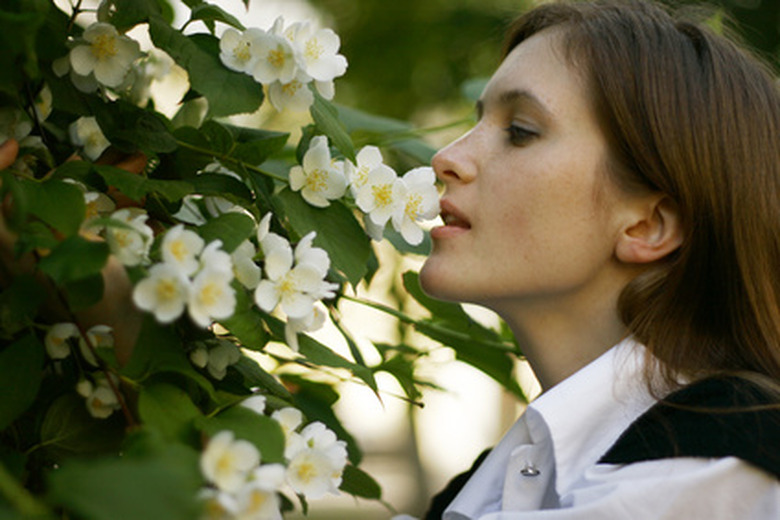Flowering Shrubs Of India
Growing between 0.5 to 4 m above the ground, shrubs are low-height plants characterized by their clustered or spread branches arising from the base of the plant. They may be herbaceous, semi-woody or woody in nature and can be flowering or nonflowering. Shrubs need little or no care to grow. The tropical climate of India is ideal for shrubs; therefore, many rare and beautiful shrubs grow in India.
Chandnee
Generally referred to as Tagar or Chandnee, the botanical name of this Indian flowering shrub is Tabernaemontana coronaria. The plant bears many glittering, sweet-smelling white flowers on ash-colored twigs spread on coarse, furrowed branches. In the wild, the shrub bears solo flowers. When grown in gardens, the flowers often grow in pairs. The calyx gives way to a pale-yellow tube that blooms into overlapping, wavy-edged petals. The leaves of the plant are usually bottle-green in color, light-green when young. They have concave veins, an oval shape and a glossy feel and grow crosswise up to 4 inches in length, tapering to a petite stalk. Moist, fertile soil and lots of sunlight are ideal for this shrub to grow. A healthy plant can grow anywhere between 6 to 10 feet in height and 5 to 8 feet in width.
- Growing between 0.5 to 4 m above the ground, shrubs are low-height plants characterized by their clustered or spread branches arising from the base of the plant.
- The leaves of the plant are usually bottle-green in color, light-green when young.
Hibiscus
Popularly known as Gurhul, Jaswand, Jaba or China Rose in India, the botanical name of this flowering shrub is Hibiscus rosa-sinensis. An evergreen shrub, it can grow in dry conditions, even with little care. This bushy shrub bears large, single flowers. The Hisbiscus flowers are characterized by their long, hanging stamens with anthers. The calyx is distinct. Enveloping the five sepals is a secondary calyx that is made of several narrow pointed leaves. Belonging to the Malvecee family, Hibiscus is available in various bloom sizes and colors. Red is the primary color of Hibiscus rosa-sinensis. The leaves of the plant are dark green and a bit waxy with prominent veins. They have serrated borders and grow alternately on a short stalk. To get a healthy Hibiscus shrub, give it organic, rich, well-drained soil. To ensure the proper growth of the shrub, cut, graft and layer it in a timely manner. The plant is prone to pest and fungal attacks. Metacid 50 and Carbaryle can help save the plant from major insect attacks. Thoroughly hosing down the plant with a mild detergent may also work.
- Popularly known as Gurhul, Jaswand, Jaba or China Rose in India, the botanical name of this flowering shrub is Hibiscus rosa-sinensis.
- An evergreen shrub, it can grow in dry conditions, even with little care.
Jasmine
Jasminum pubescens, commonly known as Jasmine, Jui or Chameli, is a popular flowering shrub of India, known for its scented, star-shaped, white little flowers. The shrub usually grows 5 to 10 feet tall, like an umbrella, spread over knolls, archways and hedges. The flowers grow in clusters blooming amidst soft, heart-shaped, dull-green leaves. Jasmine needs well-drained, fertile soil with adequate amounts of sunlight and water during its growing period. Grow Jasmine between summer and fall. Do not overwater the plant. Rot root kills Jasmine. Also, fungal and bacterial leaf spots, viruses and insects are common problems. Pruning is needed from time to time for better growth.
- Jasminum pubescens, commonly known as Jasmine, Jui or Chameli, is a popular flowering shrub of India, known for its scented, star-shaped, white little flowers.
Baramasi
Popular in India as Sadafuli or Baramasi, Catharanthus roseus is a perennial shrub with a bushy appearance. It blooms with tender, small, leafy flowers. The blooms are peach and pink colors, with a dark center eye in the five petal flowers. Shining, dark-green, elliptical leaves with prominent mid-veins and blending veins grow like a bush, lending volume to the plant. The shrub needs unblocked sunlight, but even partial shade works well. The soil has to be porous enough to drain off excess water, and the fertility level should be average. The best season to grow the plant is early spring. Common problems are pests, stem rot and leaf spots.
- Popular in India as Sadafuli or Baramasi, Catharanthus roseus is a perennial shrub with a bushy appearance.
- The blooms are peach and pink colors, with a dark center eye in the five petal flowers.
